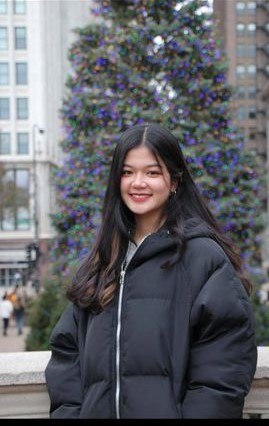International Students Share Their Holiday Traditions
Written by Bailey Smith and Giang Nguyen, Schmidthorst Communications Interns
It’s the most wonderful time of the year! The Schmidthorst College of Business proudly celebrates its diverse and inclusive community and their holiday traditions. Our faculty, staff and students enjoy learning about holiday traditions from the different cultures represented in our college.
 Gurtej Singh Puri is a second-year student from Delhi, India, studying business management and finance. India’s biggest and most important holiday is Diwali, the Festival of Lights. Diwali’s dates are based on the Hindu lunar calendar, and typically occurs in October or November. The Festival of Lights is celebrated differently among the religious sects in India, such as Hindus and Sikhs. But what they all have in common is the many lights and oil lamps lining the streets and houses, visiting with relatives and having feasts, fireworks and festivals. Special foods eaten during Diwali include samosas, a fried or baked pastry with a savory filling; puri, deep-fried bread made from unleavened whole wheat flour; and pakora, a popular fried snack.
Gurtej Singh Puri is a second-year student from Delhi, India, studying business management and finance. India’s biggest and most important holiday is Diwali, the Festival of Lights. Diwali’s dates are based on the Hindu lunar calendar, and typically occurs in October or November. The Festival of Lights is celebrated differently among the religious sects in India, such as Hindus and Sikhs. But what they all have in common is the many lights and oil lamps lining the streets and houses, visiting with relatives and having feasts, fireworks and festivals. Special foods eaten during Diwali include samosas, a fried or baked pastry with a savory filling; puri, deep-fried bread made from unleavened whole wheat flour; and pakora, a popular fried snack.
Gurtej’s family also celebrates both Christmas and New Year’s. One of the most common things to decorate with during a festival is a lantern. Christmas is a smaller holiday in India, but Christmas trees are popular. Christmas day is celebrated with loved ones getting together and sharing a meal.
 Kexin Lyu is a first-year graduate student from Ji nan, Shan dong, China. Two traditional holidays Kexin celebrates are New Year’s and Spring Festival. The celebration of New Year's Day in modern China is much less important than the Spring Festival. For New Year’s, she usually watches TV shows with her family.
Kexin Lyu is a first-year graduate student from Ji nan, Shan dong, China. Two traditional holidays Kexin celebrates are New Year’s and Spring Festival. The celebration of New Year's Day in modern China is much less important than the Spring Festival. For New Year’s, she usually watches TV shows with her family.
Spring Festival is celebrated on the first day of the first lunar month, typically occurring in January or February. The night before the Spring Festival is called Spring Festival's Eve, which is an important time for family reunion. The whole family gathers together and eats a sumptuous dinner. Many people stay up all night and call it "shousui." The next day, everyone visits relatives and friends' homes to greet each other, wishing all the best in the new year.
Lunar New Year's money is one of the customs of the Spring Festival. After the New Year's dinner, the elders distribute the Lunar New Year's money to the younger generation. It is said that the new year's money can suppress evil spirits, and the younger generations can spend the first year peacefully after receiving the Lunar New Year's money.
Kexin goes to the temple to burn incense and pray during the Spring Festival holiday with her family. The usual place for dinner is at her grandma's house. Eating dumplings is a unique way of expressing people's wishes when they leave the old and welcome the new. In addition, dumplings are shaped like ingots, and making dumplings symbolizes enclosing luck.
If the majority of the world throws their end-of-year parties around late December or early January, for Vietnamese, the holiday season doesn’t fully kick in until roughly two months later. Lunar New Year (or “Tet” in Vietnamese), whose time of celebration is determined by the lunisolar calendar, has been an irreplaceable part of Vietnamese culture. Tet is an occasion for family reunion, well-wishes, traditional customs and endless feasts.
Apart from several overarching Lunar New Year rituals that families across the nation have in common, such as giving out “lucky money” for elders and children, the way in which Vietnamese families celebrate the holiday differs from region to region. An example is the contrast between the northern vs. southern styles of carrying out Tet customs.
 Third-year student Katie Ho, who is double majoring in supply chain management and business analysis, is a Ho Chi Minh City-native of Southern Vietnam.
Third-year student Katie Ho, who is double majoring in supply chain management and business analysis, is a Ho Chi Minh City-native of Southern Vietnam.
“In the North, where spring breezes and drizzles are a thing, people decorate their house with peach blossoms, which can survive the cold weather,” she said. “But in the warmer South, we do apricot blossoms, which only bloom in the heat.”
In terms of food, Northern wind chills call for cold-weather food such as the jellied meat loaf and the indispensable “banh chung,” a type of rice cake with bean/pork stuffing. In the South, Katie’s family enjoys “banh tet,” which essentially is “banh chung” but in cylindrical shape, in addition to stuffed bitter melon soup, and caramelized pork with quail eggs.
Tet is traditionally regarded as a time of “returning home,” but this might not ring true to certain families. As much as Tet is a traditional celebration, each may choose to follow or discard certain customs depending on their unique situations. Katie’s family usually makes the best out of the annual seven-day holiday break by traveling.
“My family is a bit different,” she said. “We still go out shopping for new stuff, and clean the house before New Year’s Eve, but on the last day of the year, we'd pack our suitcases and go on a trip. Every year, we celebrate midnight in different locations across Vietnam.”
In contrast, Hanoi-born Hien Nguyen, a second-year business management major, cherishes age-old family traditions within the vicinity of his home.
“In the last few minutes before the clock strikes 12, our family would step out of the house to catch the local firework display,” Hien said. “After that, the head of the family (colloquially referred to as the “pillar of the household”) is invited to step in the house first for good luck. About an hour later, we would visit a nearby pagoda to pray for good fortunes, then call it a night in order to be fully charged for the first ‘day’ of the year.”
The COVID-19 pandemic might shake things up and throw any traveling or major family reunion plans out the window, but Hien remains optimistic about the 2021 Tet celebration.
“Vietnam has done a very good job handling the pandemic,” he said. “So despite the ups and downs we’ve been through in 2020, I still think people will uphold the holiday spirit, and pray that 2021 will be a better year for all.”
Updated: 11/18/2020 11:48AM
